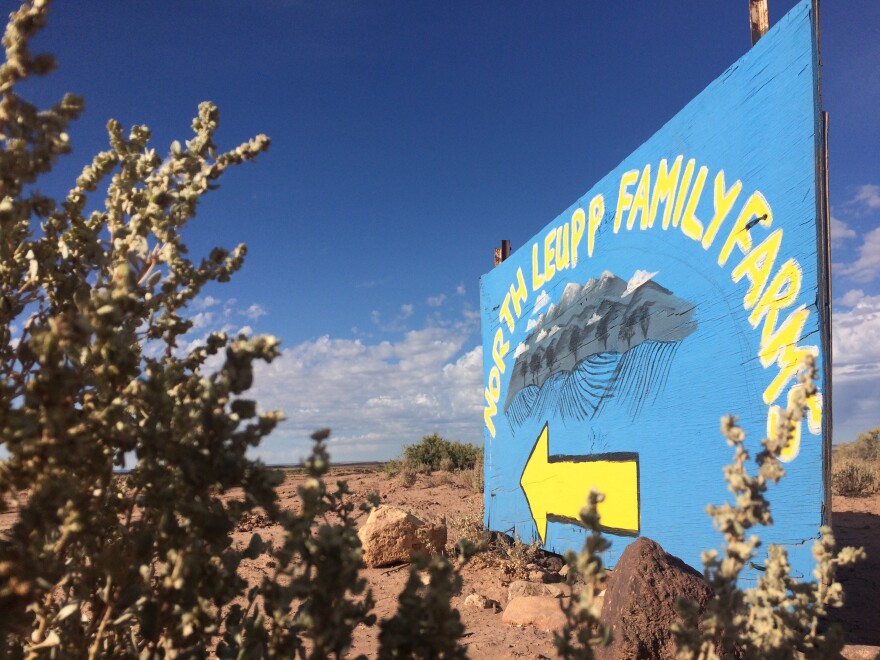Oil and gas drilling and mining companies come to rural areas offering jobs and cash, but they also dig into the land, pull resources out of it and create pollution. There are some folks in these regions who say the trade off isn’t fair in the long run. One organization is working on the Navajo Nation to stabilize the boom-and-bust economy of extraction by boosting local entrepreneurs and small business.

When you’re standing on the North Leupp Family Farm, you can see for miles. There are not many other people or houses nearby. Just the mountain in the distance. Stacey Jensen is the manager of the nonprofit farm. "These are sweet corn here, heirloom sweet corn here. And they were really delicious," he said.
Thirty or more families around here farm cooperatively and bring home fresh food to their families. Most of the crops have already been harvested. "You should see it," Jensen said. "It’s quite a sight to see all the children, and the folks out the fields on weekends or in the evenings when it cools off."
Small businesses like this farm could help the struggling economy on the Navajo Nation—one that rises and falls with the ups and downs of the fossil fuel industry.
"I think this farm can be duplicated elsewhere," Jensen said. "But, again, it depends, you’ve got to have water, you’ve got to have land, OK, and then you’ve got to have community to really make this thing grow."
Jensen’s been able to hire local people to work on the farm, and he’d like to hire a lot more in the years to come. But starting any business out here can be hard, he said, because on some parts of the Navajo Nation they’re missing the basics—Internet access, water, sewer or electricity. "Well, you know, as you can tell, we often do with little or no resources out here," he said. "But we do a lot."
No one’s really sure how many small businesses there are here, because people across the region do business without registering. It could take years for Navajo entrepreneurs to get access to property on the reservation. Leasing and building involved jumping over many U.S. government hurdles. And the process is expensive.

Navajo Nation President Russell Begaye said all of that started changing as of April 1 this year when the Nation took control of leasing and zoning their lands. "We’re moving towards: How do you help some of the entrepreneurs?" he said. "A lot of the people here, they don’t have equity, they don’t have assets, they don’t have moneys that they can put into business."
The Navajo Nation government created a $20 million fund to help small businesses get started, Begaye said. The tribe also just got control of telecommunication right-of-ways. For President Begaye though, it’s not about moving away from extractive industry. The government has its eye on owning and running oil and gas, and mining operations, instead of just leasing the land to corporations. He said that would mean way more tribal revenue.
"You have to provide incentives for people to come home," he said. "They all want to come home. This is their land. This is the land of their ancestors, and they feel a part of this whole Navajo Nation."
Jobs today though are still hard to come by. Unemployment numbers are difficult to pin down: Reports say the rate is around 21 percent, but other tribal officials say it’s double that or more.
Jessica Stago is the lead business counselor at the Native American Business Incubator Network. "There’s threats to the jobs held by coal miners and employees that work for the power plants in this area," she said. "While the extractive industries did provide jobs for our people, it didn’t leave us with an economy that we could rely on."

The wave of jobs that flooded in three or four decades ago is receding, Stago added, "so we’re trying to figure out a way where we can build a local economy that is self-sustaining, versus being dependent on these extractive industries, because those industries are dependent on the larger population and trends."
Stago’s incubator helped the North Leupp Family Farm get a grant from the USDA to work on selling their traditional blue corn in other areas. It’s all about keeping local dollars flowing between local people, she says, and supporting the resourcefulness and ingenuity of folks who live on the Navajo Nation.
***
This story is part of the Solutions Journalism Network's State of Change project, examining how rural communities are adapting to the changing economy.





